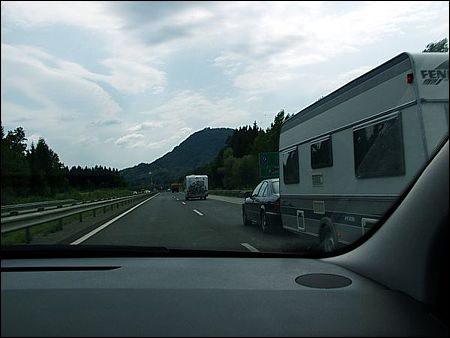All Roads Lead to…
Driving from Brussels to Ljubljana, one gets a quite different perspective of our European partners, one that shows them in a more natural light.
First, it’s through eastern Belgium and into Luxembourg, a route dictated by the fact that fuel prices in the latter are significantly lower than in most of Europe. The odd bit of road-‘works’ notwithstanding, most of Belgium is paved with rocks and holes, held together with varying grades of gravel.
It is true that the motorways also have some flat sections, but they only serve to convey you at a higher speed than would be recommended for approaching the next rock, hole or both. Either as a consequence or as a cause, Belgians do not treat their cars as anything other than modes of transport, preferably in working order, designed wholly as a means of getting their contents from one place to another. Often in the same state as when they started their journey.
You can usually tell a Belgian car, not from its funny red-letter number plates, but from the various striations, dents, gouges and expert use of gaffer tape applied to bumpers, wings and windows. If you can get close enough while driving that is, because the driver will be making his/her way to their destination with the aid of Garminoutinoutshakitallabout, or Wiggle Maps, without regard for anybody else who might be doing the same.
Over the border in Luxembourg, everybody drives Audis just fast enough not to overshoot the ever-present borders. The cars are immaculate because a) cars must be new by law and they’re not new if they’re over a year old, and b) the servants keep them in immaculate condition. These same servants are also employed to get the refuelling done, as a Luxembourger would obviously not consider the possibility of getting their manicure petrolified.
The service stations are a state-owned entertainment system, where the fuel prices have been subsidised in order to attract poor foreigners, who gorge themselves on diesel and ‘food’ that is based on recipes from Polish milk bars circa 1978. Images are beamed into the homes of the citizenry, not just as a live comedy show, but as a public service reminder that their country floats above the rest of Europe, on a kind of superiority cloud.
Germany. Oh dear me, Germany; a land of myth and fantasy, of dreams, ideas, aspirations and great possibilities.
The myth is of the Great German Machine, forging its autobahns across whole kilometres of land, linking up forty year-old motorways that have seen better days thirty years ago, interminable road works and not a service station in sight for hundreds of hours and when you see one it’s populated by mullet-headed style-free thugs stuffing themselves with greasy wursts while filling their hairy ears with Europap. Autobahns, on which it is legal to tear along at whatever maximum speed your vehicle can muster, but where it is impossible to do so, on account of the state of the roads and that they are full of FUCKING CARAVANS and MOBILE ‘HOMES’. And trucks – trucks trucks trucks trucks trucks trucks trucks.
For a different perspective of the differences between northern Europe and the south, consider how the northerners go on holiday. All through the summer, the roads south – especially to Croatia, where the sun is hot and the food is cheap – are clogged with Germans, Dutch, Belgians, Danes and a few Brits making a change from Spain/France, towing their FUCKING CARAVANS. Caravans in which they will stay, rather than spend their northern riches on southern accommodation, swarming their moneyed families into traditional (read ‘cheap’) eateries where they can partake of the dish of the day, washed down with tap water.
If the northern cheap middle classes would only spend their affluence on proper holidays with their southern neighbours, the whole debt crisis would have been avoided, while Europe’s roads would be cleaned up at a stroke.
And finally into Slovenia. Which will require a post all of its own.


Recent Comments